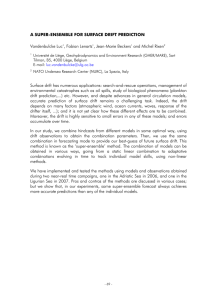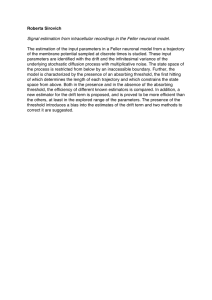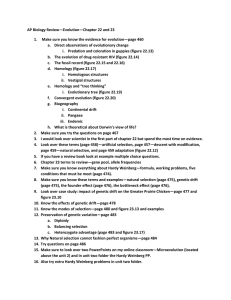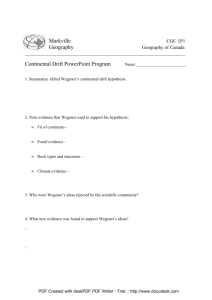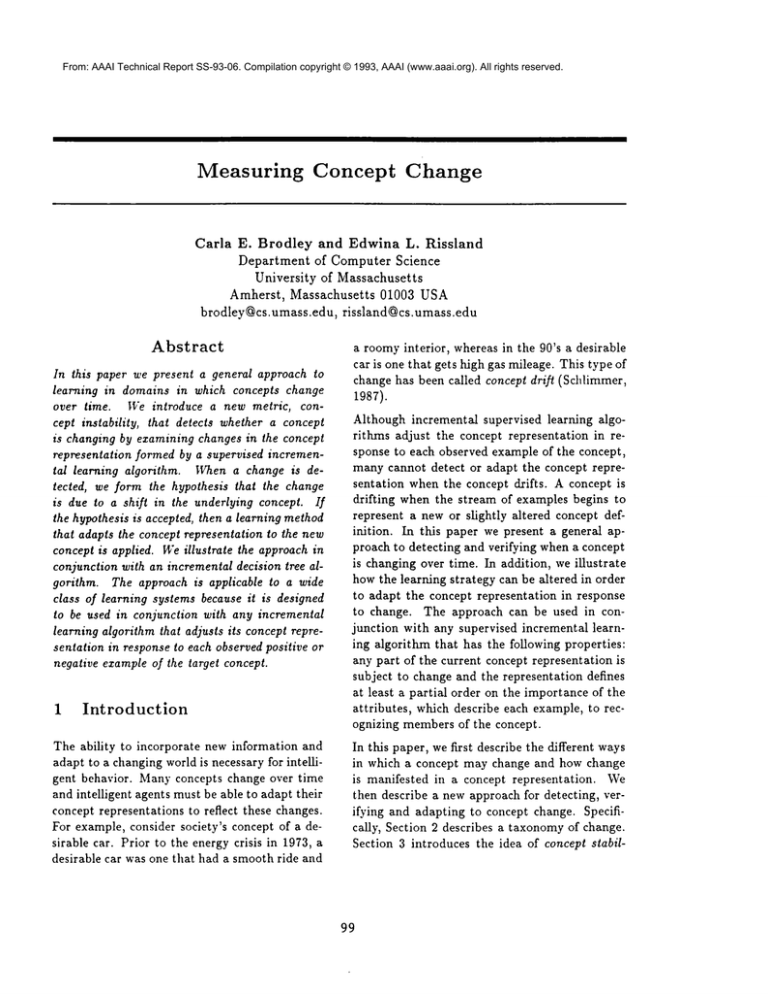
From: AAAI Technical Report SS-93-06. Compilation copyright © 1993, AAAI (www.aaai.org). All rights reserved.
Measuring
Concept
Change
Carla
E. Brodley and Edwina L. Rissland
Department of Computer Science
University of Massachusetts
Amherst, Massachusetts
01003 USA
brodley@cs.umass.edu,
rissland@cs.umass.edu
Abstract
a roomy interior, whereas in the 90’s a desirable
car is one that gets high gas mileage. This type of
change has been called concept drift (Schlimmer,
In this paper we present a general approach to
learning in domains in which concepts change
over time. We introduce a new metric, concept instability,
that detects whether a concept
is changing by examining changes in the concept
representation formed by a supervised incremental learning algorithm. When a change is detected, we form the hypothesis that the change
is due to a shift in the underlying concept. If
the hypothesis is accepted, then a learning method
that adapts the concept representation to the new
concept is applied. Weillustrate the approach in
conjunction with an incremental decision tree algorithm. The approach is applicable to a wide
class of learning systems because it is designed
to be used in conjunction with any incremental
learning algorithm that adjusts its concept representation in response to each observed positive or
negative example of the target concept.
1
1987).
Although incremental supervised learning algorithms adjust the concept representation in response to each observed example of the concept,
many cannot detect or adapt the concept representation when the concept drifts. A concept is
drifting when the stream of examples begins to
represent a new or slightly altered concept definition. In this paper we present a general approach to detecting and verifying when a concept
is changing over time. In addition, we illustrate
howthe learning strategy can be altered in order
to adapt the concept representation in response
to change. The approach can be used in conjunction with any supervised incremental learning algorithm that has the following properties:
any part of the current concept representation is
subject to change and the representation defines
at least a partial order on the importance of the
attributes, which describe each example, to recognizing members of the concept.
Introduction
The ability to incorporate new information and
adapt to a changing world is necessary for intelligent behavior. Many concepts change over time
and intelligent agents must be able to adapt their
concept representations to reflect these changes.
For example, consider society’s concept of a desirable car. Prior to the energy crisis in 1973, a
desirable car was one that had a smooth ride and
In this paper, we first describe the different ways
in which a concept may change and how change
is manifested in a concept representation.
We
then describe a new approach for detecting, verifying and adapting to concept change. Specifically, Section 2 describes a taxonomy of change.
Section 3 introduces the idea of concept stabil-
99
ity as a heuristic metric for measuring concept
change over time. In Sections 4 and 5 we describe a method for detecting and verifying concept change using this metric. We apply the
method in conjunction with an incremental decision tree algorithm IDbR(Utgoff, 1989). In Section 6 we demonstrate how the method works in
response to varying amounts of concept drift and
finally, in Section 7 we discuss how our approach
relates to other approaches for handling concept
drift.
2
Concept
the change. Note that for several of the examples, not all five attributes will be important to
classification and therefore will not appear in the
tree. The types of change are:
.
Change
.
There are many ways in which a concept can
change over time: a concept can become more
general or more specific, the relevance of the attributes describing the concept can change, or
the correlation between the value of an attribute
and the concept definition can change. In this
section we present a (partial) taxonomyof change
and we describe how changes are manifested in a
variety of concept representations.
2.1
Taxonomy
of
Concept
.
Changes
Wedescribe a taxonomy of changes that may occur for concepts that can be represented in Disjunctive Normal Form (DNF). To illustrate
the
types of change, we use five Boolean Attributes,
A, B, C, D and E to describe a concept and we
use a decision tree to represent the concept. Each
exampleis labeled positive (4-) or negative (-)
indicate membership or non-membership in the
concept respectively. In a decision tree a node
is either a leaf containing the name of a class or
a decision node containing a test. For each possible outcome of the test there is a branch to a
decision tree or a leaf. To classify an instance,
one starts at the root of the tree and follows the
branch indicated by the outcome of each test until a leaf node is reached. The name of the class
at the leaf is the resulting classification. Wedescribe six types of change and depict each type
by drawing the decision trees before and after
.
.
.
i00
Adding a new disjunctive
condition
generalizes the concept. For example, in
Figure 1 the concept changes from AB V C
on the right to AB V C V D on the left.
Adding a disjunctive clause to the concept
causes one of more nodes to be added to a
decision tree.
Removing a disjunctive
condition
makes the concept more specific.
For
example, in Figure 1 the concept changes
from AB V C V D on the right to AB V C
on the left. Removing a disjunctive clause
from the concept causes one or more nodes
to be removed from the decision tree.
Adding an additional
exception
makes
the concept more specific.
For example,
in Figure 2 the concept changes from AB Y
CD on the left to AB V CDEon the right.
Adding a conjunction to one of the clauses
adds one or more nodes to the tree.
Deleting an exception generalizes
the
concept.
For example, in Figure 2 the
concept changes from AB V CDE on the
right to AB V CDon the left. Removing a
condition from a clause removes one or more
nodes from the tree.
The importance
of an attribute
changes. For example, in Figure 3 the
concept changes from AB V C on the left
to AD V C on the right.
The new concept has the same number of clauses, but
the change in importance causes nodes to
be both added and deleted from the tree.
An attribute’s
value with respect to
the concept has been inverted.
For example, in Figure 4 the concept changes from
AB V C on the left to AB V ~C on the
ABvCvD
ABvC
C
C
+
+
-
+
Figure 1: Concepts AB V C and AB V C v D
AB v CD
AB v CDE
A
A
×\o c;,’x
" ¢"v AT".t
/~E / \D
- ,A,A-’+ . ,o
~
.¯ ,,
I
+
I
"4"
.
FAT
+
Figure 2: Concepts AB V CD and AB V CDE
ABvC
ADvC
Figure 3: Concepts AB V C and AD V C
101
Figure
4: Concepts
AB V C and AB V ~C
right. Negation of an attribute in a clause
causes the subtrees of the corresponding test
to switch branches.
2.2
Computational
Manifestations
Concept
Change
of
Given a set of positive and negative examples of a
concept, each described by a set of attributes, the
goal of a supervised learning algorithm is to induce a generalization of the examples that can accurately distinguish objects as members or nonmembers of the concept. Typically, the values
of some attributes are more indicative of concept membership than others. For example, if
the concept to be learned is "chair" and each example is described by the attributes number of
legs and color, then clearly, the value of number
of legs is more predictive of whether an object is
a chair.
Most inductive learning algorithms attempt to
learn which attributes are most predictive of the
concept. For example, ID5R generates a decision
tree which defines a partial ordering of the importance of the attributes; one attribute is judged
more important than another if it is closer to the
root of the decision tree. (The depth of nodes in
a tree does not define a total ordering on the attributes because two attributes at the same depth
in the tree have the same importance.) As
second example, in a concept hierarchy formed
by COBWEB
(Fisher, 1987), attributes
tested
higher in the hierarchy are more important for
102
categorization than those tested lower in the hierarchy. In the case-based systems, HYPO(Ashley, 1990) and CABARET
(Rissland & Skalak,
1991), cases are ordered by how "on point" they
are for argumentative purposes. The partial order is represented in the "claim lattice" in which
cases nearer the root of the lattice are more on
point than those lower down; cases appearing at
the same level are considered equally on point.
3
Recognizing
Concept is
When a
Changing
The ordering of the attributes by their importance for predicting concept membership leads
directly to the idea of concept stability. Wedefine
concept stability
to be a measure of how much
the ordering changes in relation to the number of
observed examples. If the concept is not changing, then as the number of observed examples
increases the ordering stabilizes and therefore,
the concept stability increases or equivalently,
the concept instability decreases. Note that initially the ordering will fluctuate because when
few examples have been observed it is difficult
to ascertain correctly which attributes are most
important. In this section, we introduce a measure for analyzing change and we describe how
to compute concept instability over time.
3.1
Measuring
Structural
tal", shows the sum of all changes. For example,
if a disjunctive clause is added to the concept
(see Figure 1), then one node changes at level
and change2 = 1.(6-2)/6.
At level3 aleaf
changes to a test and a test changes to a leaf,
change3 = 2 * (6 - 3)/6, at level 4 two leaves
are removed, a leaf is added and a test is added,
change4= 4 ¯ (6 - 4)/6, and at level 5 two leaves
are added, changes = 2 * (6 - 5)/6. Total change
for the decision tree is the sumof the changei for
i = 1, .., 6, and in this case, is equal to 2.83.
Change
By examining the structure of a concept representation we can measure the change in importance of the attributes used in predicting the
concept, for instance as reflected by the structural changes in a decision tree representation.
A structural
measure of change can be implemented with any concept representation that defines a partial order of the attributes’ importance
to predicting class membership. For the purpose
of clarity, in the following discussion we illustrate
the measure using a decision tree representation.
3.2
In a decision tree, each time a node is created,
deleted, or the attribute at the node is replaced
by a different one, the concept representation
changes, as discussed in Section 2.1. The importance of the change is determined by its depth in
the decision tree; since attributes tested further
away from the root of the tree are less important
to classification, we want to pay less attention to
changes further away from the root. Our structural measure of change achieves this by weighting a change at depth i in the tree by (n - i)/n,
where n the maximumpossible depth of the decision tree and is equal to the number of attributes
plus one. After each new example is observed,
to measure the change in the tree representation we can compute the sum of the changes at
each depth in the tree. Specifically, if K nodes
at depth i in the tree change, then the change at
depth i is computed as: changel = K × (n- i)/n.
The total change for the tree is then:
Concept
Instability
Concept instability is a measure of change over
time. To determine if a concept representation is
becoming stable one looks for trend in the measure of change. A stable concept is one where
change decreases over time. To compute the
amount of change over time we update the statistic:
instability
= ~ ~-~.~=1 Tchangej
Where Tchangej is a measure of change between
the tree based on j - 1 instances and the tree after the jth instance in added, and E is the total
number of instances observed thus far. Because
the number of changes in the tree is normalized
by the number of observed examples, E, as E increases the instability will decrease if the concept
is not changing. The actual value of instability
at any one point in time may not in itself yield
any information about the concept stability since
it only reflects change over one "time" step.
Tchange = ~_,in=l changel
4
]-able 1 shaws how to compute the measure for
each of the examples of change presented in Section 2.1. In each example of change there were
five attributes which described the instances.
Therefore, the maximumdepth of a decision tree
is 6; the depth of the root of the tree is 1, the
maximumdepth of a test node in the tree is 5,
and the maximum
depth of any leaf in the tree is
6. In ]?able 1, columns 1-5 show the measure for
each level in the tree and the last column, "To-
Detecting
Concept
Change
In this section we describe how to use concept
instability to detect concept change. If a concept becomesunstable, there are two possible explanations: the partial ordering of the attributes
(eg., the structure of the tree) has changed because new examples were observed from a different part of the example space than observed
previously or because the concept is drifting. De-
103
Table 1: A Structural
Type of Change
Add aClause
Delete aClause
Add Exception
Delete Exception
Relevance Change
Clause Negated
Measure of Change
1
2
3
4
5
0 1"(6-2)/6
2*(6-3)/6
4*(6-4)/6
2*(6-5)/6
0 1"(6-2)/6
2*(6-3)/6
4*(6-4)/6
2*(6-5)/6
0
0
0
1"(6-4)/6 3*(6-5)/6
0
0
0
1"(6-4)/6 3*(6-5)/6
0
0
1’(6-3)/6
4*(6-4)/6
0 2*(6-2)/6
3*(6-3)/6
4*(6-4)/6
pending on the cause of the increase in instability,
different learning strategies should be employed.
If the increase is due to more information, then
we can continue to train the existing concept representation. On the other hand, if the concept
is drifting, then the effect of examples observed
in the past should be removed from the concept
representation. If the drift is not radical then
removing all examples prior to the drift would
throw away all previous effort (Schlimmer, 1987).
Thus, we retain the the current concept representation and as new examples are observed, we
discount the effect of examples observed further
in the past. Rather than choose erroneously between the two explanations, we test the hypothesis that a increase in instabihty is caused by drift.
In Section 5 we describe a method for verifying
concept drift by testing this hypothesis.
To detect possible concept drift we examine the
instability of the concept representation. To detect whether the instabihty is increasing or decreasing we use a statistical
measure of trend,
Kendell’s 7- test (Kendall, 1962). The 7- test
a nonparametric test of correlation between two
variables, z and y. Given n data points, (z/, y/),
the 7- statistic measures the degree of positive
or negative correlation between z and y. In our
implementation, z/ is the value of the instability metric, defined in Section 3.2, after examplei
has been observed and y/counts how many examples have been observed (y/ = i). The 7- statistic
is approximately normally distributed.
Values
close to +1 indicate a high positive correlation
Total
2.83
2.83
0.83
0.83
1.83
3.50
and values close to -1 indicate a high negative
correlation. To measure whether the concept instability is increasing or decreasing we compute
the 7- statistic
for a windowof n data points,
where n equals the number of attributes.
To detect that the concept may be drifting we
must first observe that it has stabilized. Wedefine a concept as stable if the probabihty that
there is a decreasing trend in the concept instabihty measure is higher than 95% as computed
by the 7- test. If we observe an increasing trend
in the instabihty after it has stabilized, then we
form the hypothesis that the concept is drifting.
5
Verifying
Concept Drift
In this section we describe howwe can verify concept drift when using an incremental supervised
learning algorithm. Although we illustrate
the
approach in conjunction with an incremental decision tree algorithm, ID5R (Utgoff, 1989), the
approach can be applied to any algorithm that
is able to removethe effect of instances observed
in the past. ID5R retains all observed examples
in the tree so that at each test node in the tree
enough information is kept to calculate the information theoretic measure (used to select which
attribute to test at each node) of each attribute
not tested above this node in the tree. The remainder of each example is stored in the appropriate leaf of the tree. During training, if an attribute tested at a node becomes less predictive
104
than another attribute tested closer to the root
of the tree (as measured by the information-gain
ratio metric), then IDSRrestructures the tree so
that the desired test attribute is pulled up to the
root of the tree or subtree. This method of restructuring the tree permits ID5Rto recalculate
the data necessary for the information theoretic
measure without re-examining every attribute in
training examples.
higher, then we accept the hypothesis that the
concept is drifting. If the accuracy of the new
tree is the same or lower than the accuracy of
the old tree, then we reject the hypothesis. If
the concept is not drifting, then either the old
tree will be more accurate (due to the fact that
it is based on more examples) or there will be
no difference in the accuracies of the two trees.
However, if the concept is drifting, then the new
tree will obtain a higher accuracy because some
of examples of the concept observed prior to the
drift have been removed.
Whenthere is an increase in concept instability
it is not obvious whether the increase is caused
by concept drift or due to observing new examples. Rather than choose erroneously, we form
and test the hypothesis that the increase is due
to drift. To this end, we begin by making a copy
of the current ID5Rtree, called the new tree. We
then continue to train the original tree using the
ID5R algorithm. We train the new tree using
a different procedure; for each new example observed we remove the example observed furthest
in the past, which is still part of the new tree.
Over time, this removes the influence of old examples from the new tree and may result in ID5R
restructuring the tree. This procedure requires
that there be a way to determine the age of each
instance. We achieve this by marking each instance with the time that it arrives.
To test the drift hypothesis, we continue to train
both the old and the new tree until either one
or both trees have an increasing concept stability, as measured by the r test. If the old tree
becomes stable and the new tree does not, then
we reject the hypothesis. In this case, the instability is attributable to not having observed
enough examples to converge to a stable concept
description.
The case where only the new tree
becomes stable will never arise. Even if a concept is drifting the old tree will eventually become stable (albeit with an inaccurate concept
description) and we want to wait until that point
to make a knowledgeable choice. If both trees are
stable, then we examine the accuracy of each tree
for tile examplesobserved after the possible drift
was detected. If the accuracy of the new tree is
If the drift hypothesis is accepted, then we continue removing examples observed prior to the
point when drift was detected. Because we may
verify the hypothesis before the effect of all the
examples of the old concept are removed, we need
to continue to remove the old examples. Once
we reach the point where further removal causes
the tree to become incorrect for examples observed after the drift, we revert to ID5R’s training method, retaining all remaining and new examples in the tree. Once the hypothesis is accepted or rejected, we continue training with the
chosen tree. Note that when we resume training
with one tree, the concept drift detection mechanism is turned on again.
6
Illustration
To understand how the stability
metric can be
used to detect concept drift, we show results
for an artificial
domain in which the concept is
changing. The concept changes from AB V DE V
CG to AB V CDE. We created 256 unique examples for each concept (there are 8 Boolean attributes and 2 classes). Wepresented ID5R with
examples of the concept AB V DE V CG in random order. We then presented examples of the
concept AB V CDEin random order. A graph of
the concept instability measure,is shown in Figure 5. The y-axis shows the instability and the
x-axis shows the number of instances observed
thus far. The instability measure is cumulative:
105
20
10
I
0
0
Figure
I
I
100
200
300
Number of Training
5: Instability
for the concept:
a positive slope for some number of instances
indicates that the tree is undergoing structural
changes, whereas a negative slope indicates that
the decision tree representation is stabilizing.
The trend measure detects stability after 71 instances have been observed. After the 100’th
instance is observed the tree representation begins to change again. After 112 examples have
been observed the system detects that the concept may be drifting. At this point it makes a
copy of the current concept representation, and
begins to train the two trees. After 163 examples
have been observed, both the new tree and the
old tree have stabilized. At this point the system
rejects the hypothesis that the concept is drifting, because the accuracy of the old tree for the
examples observed after the drift is higher than
that of the new tree. The system then continues
to train only the original tree (the original tree
is based on all 163 observed examples).
The small rises in instability at 156 instances and
229 instances are not significant enough to cause
the drift detection mechanismto signal a possible
change. After 271 examples have been observed
the system again detects a possible drift. After
322 examples have been observed both trees are
stable, but the accuracy of the new tree is higher,
veri~’ing the drift hypothesis. At this point the
I
400
Instances
I
500
Observed
AB V DE V CG ’,,
AB v CDE
system discards the original tree and continues
training the new tree. It continues to train the
tree until all 512 examples have been observed.
The accuracy of the final concept description was
100%for the examples observed after a possible
drift was detected, whereas without drift detection, the tree found by ID5R had an accuracy of
76%.
Table 2 illustrates
how the method works with
varying amount of concept change. For each
change, the table reports the percentage of
change (the number of instances that differ from
the original concept to the new concept). For
each change, we ran the system ten times, using
a different random order for the examples before
and after the drift.
The number of times the
system was able to correctly verify concept drift
is shown in the column labeled "Correct". The
table reports the average number of instances observed when drift was detected and the average
number of instances observed when drift was verified. The last two columns report the accuracy
for the instances of the new concept for ID5R
and for the concept drift version, CDID5R.
106
Table
New Concept
AB y CDEF
AB V CGH
BH V CGH
AB V CDE V F
A VCv D
7
Discussion
2: Varying
Degrees
% Change
4.7
14.1
21.9
32.8
53.1
Correct
7
9
10
10
10
and Conclusion
Incremental learning systems have the ability to
incorporate new information and some have the
additional ability to forget old information. However only a few have the ability to recognize when
old information has become incorrect and therefore should be forgotten. This ability allows a
learning system to handle concept drift.
One
such system is STAGGER,which has the ability to backtrack and therefore can remove elements (features) that have become less predictive of the concept to be learned (Sch/immer,
1987). In addition, STAGGER’s
weight learning
method permits the system to change each attribute’s relevance. Moore’s system removes old
exemplars that have a large discrepancy between
the value of a robot manipulator and the value
that the system predicts (Moore, 1990). The system has the ability to adapt to changing behavior
in a robotic system by comparing the observed
behavior (the proximal acceleration) to the predicted behavior. The methods for handling concept drift in both STAGGER
and Moore’s system depend on the characteristics of the particular learning method. In contrast, the method
described in this paper is a general method for
detecting and handling concept drift.
Another approach to handling concept drift is to
check if an new example is inconsistent with an
example observed in the past (Utgoff, 1989; Aha,
1990). Whenthis situation arises one could simply remove the effect of the example observed
further in the past. Although this approach will
of Change from AB v CDE
Detect
349
309
262
279
253
Verify
387
338
302
309
368
ID5R CD ID5R
95.3
99.9
85.9
99.5
78.1
99.8
67.2
98.8
46.9
99.1
work if there is no noise in the instances, in
noisy domains, one has no basis for believing that
the new example is better than the old example. In such situations,
using the method presented in this paper would allow the system to
check whether the inconsistency arises because
of noise or concept drift. In addition, the presented method can adapt to a drift in the concept that does not cause any inconsistencies in
the examples, which may happen when many of
the attributes are numeric.
In this paper, we presented a measure of concept change and we illustrated
how to use this
measure to detect concept drift. Wedescribed
an approach for verifying concept drift and how
to modify the learning strategy to track concepts
that change over time. The approach can be used
in conjunction with any incremental learning algorithm that has the following three properties:
its representation of the concept permits at least
a partial ordering of the attributes by their importance to classification;
at any stage during
learning, the system can change this ordering in
response to new examples; and the influence of
any example can be removed from the concept
representation.
Acknowledgments
This material is based upon work supported by
the National Aeronautics and Space Administration under Grant No. NCC 2-658, by the Office of Naval Research through a University Research Initiative
Program, under contract hum-
107
ber N00014-86-K-0764, and the Air Force Office
of Sponsored Research under contract 90-0359.
Wewould like to thank Paul Utgoff for providing us with a copy of ID5R and Jeffery Clouse
for his helpful comments.
References
Aha, David W. (1990). A study of instance-based
algorithms for supervised learning tasks:
Mathematical, empirical, and psychological
evaluations. Doctoral dissertation,
Department of Information and Computer Science,
University of California, Irvine, CA.
Ashley, K. D. (1990). Modelling legal argument: Reasoning with cases and hypotheticals. Cambridge, MA:M.I.T. Press.
Fisher, D. H. (1987). Knowledgeacquisition via
incremental conceptual clustering.
Machine
Learning, 2, 139-172.
Kendall, M. G. (1962). Rank correlation methods.
NewYork: Hafner Publishing Company, Inc.
Moore, A. W. (1990). Aquisition of dynamic control knowledge for a robot manipulator. Proceedings of the Seventh International Conference on Machine Learning (pp. 244-252).
Austin, TX: lVlorgan Kaufmann.
Pdssland,
E.L., & Skalak, D. B. (1991).
CABARET:
Rule interpretation
in a hybrid
architecture.
Internalion Journal of Manmachine Studies, 3~, 839-887.
Schlimmer, J. C. (1987). Concept acquisition
through representational adjustment. Doctoral dissertation, University of California,
Irvine.
Utgoff, P. E. (1989). Incremental induction of decision trees. Machine Learning, ~, 161-186.
108

